- Table of Content
- 1.Kiss and fly: ...
- 2.Battle of the ...
- 3.Review of sola...
- 4.Review of geom...
- 5.The Internatio...
- 6.PROBA2 Observa...
- 7.Noticeable Sol...
- 8.Geomagnetic Ob...
- 9.The SIDC Space...
- 10.Review of iono...
- 11.Action!
2. Battle of the Scientists: STCE enters the arena
3. Review of solar activity
4. Review of geomagnetic activity
5. The International Sunspot Number by Silso
6. PROBA2 Observations
7. Noticeable Solar Events (13 Dec 2021 - 19 Dec 2021)
8. Geomagnetic Observations in Belgium
9. The SIDC Space Weather Briefing
10. Review of ionospheric activity
11. Action!
Kiss and fly: New discoveries with PSP
The Parker Solar Probe reached new milestones in 2021, being the first spacecraft to fly through the Sun's corona, and tracing the magnetic switchbacks to their source. Over the next years, PSP will make even closer flybys of our star. The article underneath was inspired on the NASA's feature story at https://www.nasa.gov/feature/goddard/2021/nasa-enters-the-solar-atmosphere-for-the-first-time-bringing-new-discoveries , with a YouTube movie available at https://www.youtube.com/watch?v=LkaLfbuB_6E (NASA/GSFC).
For the first time in history, a spacecraft has flown through the Sun's upper atmosphere – the corona – and sampled particles and magnetic fields there. This major milestone from NASA's Parker Solar Probe (PSP) was announced during the 2021 American Geophysical Union Fall Meeting in New Orleans. The importance of this major step cannot be underestimated, as the corona holds many mysteries such as why it is so hot, or how the solar wind gets accelerated and as such impacts the entire solar system.
PSP was launched on 12 August 2018 from Cape Canaveral, Florida. Its main science goals are to trace the source(s) responsible for heating the corona to its multi-million degrees temperature, to find the acceleration mechanism for the solar wind, and to uncover the physical processes responsible for the accelaration and transport of the solar energetic particles. Through a series of well-calculated flybys of the planet Venus, PSP's orbit is getting altered such that the perihelions (i.e. the closest distance to the Sun during PSP's orbit around our star) are gradually lowered: from 24.8 million km during its first perihelion late 2018 to 11.1 million km in April 2021, and eventually to 6.9 million km from late 2024 onwards, which is less than 10 solar radii! Underneath graph shows the April 2021 perihelion as calculated by STCE scientists, with further descriptions in this STCE newsitem at https://www.stce.be/news/528/welcome.html It shows the trajectory from within the ecliptic as seen from Earth (left) and from above the ecliptic (right; PSP trajectory only, the blue dot on the right represents Earth). The ecliptic is the plane created by the yearly orbit of the Earth around the Sun.
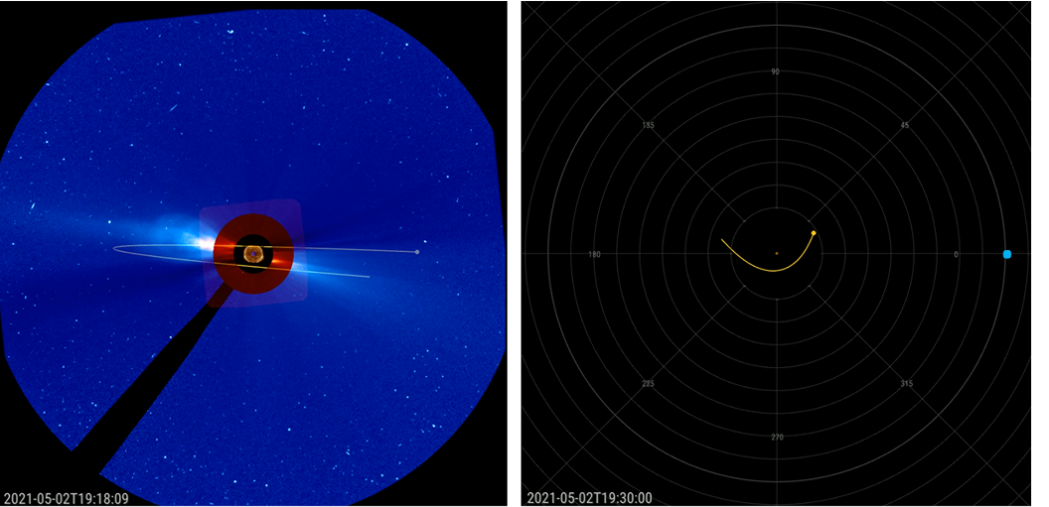
But how does one know that PSP has really flown thru the solar corona? Close to the Sun, the charged particles are bound to the Sun by gravity and magnetic forces. The continued heating pushes this plasma away from the Sun, and at some point the gravity and magnetic fields are too weak to contain it. That point is known as the Alfvén critical surface, and marks the end of the solar atmosphere and the beginning of the solar wind, which drags the magnetic field of the Sun with it as it sails across the solar system. Until now, researchers were unsure exactly where the Alfvén critical surface lay. Based on remote images of the corona, estimates had put it somewhere between 7 and 15 million km. From its sixth perihelion onwards, PSP came within this distance to the Sun, putting it in the position to cross the boundary – if the estimates were correct. Then on 28 April 2021, during its eighth flyby of the Sun, Parker Solar Probe encountered the specific magnetic and particle conditions at 18.8 solar radii (around 13 million km) above the solar surface that told scientists it had crossed the Alfvén critical surface for the first time and finally entered the solar atmosphere.
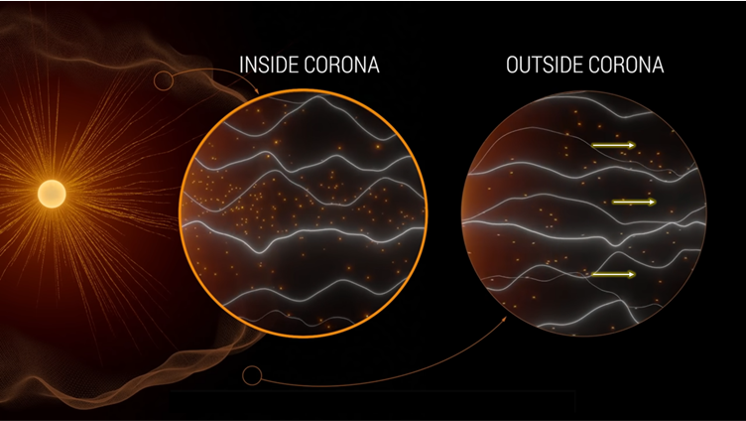
The difference in regime inside and outside the corona is shown in the annotated sketch above (screen shot from the NASA/GSFC movie). Outside the Alfvén critical surface, the solar wind particles are irreversibly gushing away from the Sun at high speeds (right circle), whereas inside this surface (in the corona ; middle circle), the Sun's magnetic field is much stronger, the particles are moving much more slowly and are more bound to the Sun. PSP also made an important discovery on the Alfvén critical surface itself. Indeed, during the flyby, Parker Solar Probe passed into and out of the corona several times. This confirmed an earlier prediction that the Alfvén critical surface isn't shaped like a smooth ball, but rather has spikes and valleys that wrinkle the surface (sketch above on the left). Discovering where these protrusions line up with solar activity coming from the surface can help scientists learn how events on the Sun affect its atmosphere and the solar wind.

PSP also made an important discovery on the magnetic switchbacks (see the above sketches), which were first discovered by the NASA/ESA mission Ulysses in the mid-1990s when it flew over the Sun's poles. Switchbacks are S-shaped kinks in the solar wind's magnetic field lines, detouring charged particles on a zig-zag path as they escape the Sun. During previous perihelion passages, the Parker probe had already discovered that these switchbacks were not confined to the Sun's polar regions, but were actually fairly common in the solar wind. During the most recent passages, PSP found that switchbacks occur in patches and have a higher percentage of helium -known to come from the photosphere- than other elements. The switchbacks' origins were further narrowed when the scientists found that the patches aligned with magnetic funnels that emerge from the photosphere between supergranules, which are 30.000 km wide convection cell structures with a lifetime of about a day. The scientists think the magnetic funnels might be where one component of the solar wind originates. The solar wind comes in two different varieties -fast and slow- and the funnels could be where some particles in the fast solar wind come from.
While the new findings could locate where switchbacks are made, the scientists can't yet confirm how they are formed. However, now that they know what to look for, Parker's closer passes may reveal even more clues about switchbacks and other solar phenomena. PSP survived its most recent perihelion at 8.5 million km on 21 November 2021, and most data will be transmitted back to Earth from 23 December till 9 January (PSP blog at https://blogs.nasa.gov/parkersolarprobe/ ). The data from this and future passes will allow scientists further glimpses into a region that is critical for superheating the corona and pushing the solar wind to supersonic speeds. Such measurements from the corona will be essential for understanding and forecasting extreme space weather events that can disrupt telecommunications and damage satellites around Earth.
Battle of the Scientists: STCE enters the arena
The Battle of the Scientists is a unique and interactive competition in which 5 scientists present their research to a room filled with hundreds of primary school children, while thousands more are watching from their classroom through a livestream.
The children organise the battle themselves and vote for the winning presentation. They do the preselection of the scientists, form a jury and present the show. They are time keepers and count the votes. Not only do they learn invaluable skills, they are also exposed to the coolest science.
STCE selected twice for the final
The theme for the upcoming battle is 'space', and so the STCE sent in two applications: 'Red alert: a solar storm is coming!' and 'Dancing aurora: heavenly creatures and science?'. Both proposals were selected by the organising school! We will get a chance to explain space weather in all its forms to these kids and hopefully motivate some of them to become scientists themselves.
Belgian Astronauts
The battle takes place during the Belgian Astronaut Week in March 2022. This event is organised to celebrate the 30th anniversary of Dirk Frimout's shuttle flight, as well as the 20th anniversary of Frank De Winne's trip to the International Space Station. Some of their American and Russian astronaut colleagues will also join for the Battle of the Scientists and will meet with the children, and the competing scientists.
May the best scientist win!

Review of solar activity
Solar activity was at low to moderate levels for the majority of the week, with a series of C-class flares and an M1.2 (NOAA 2011) flare occurring. Thirteen Active Regions (AR) were present on the side of the Sun facing Earth, ten of which were situated on the southern hemisphere. The majority of the regions had a beta configuration, while two (NOAA 2907, NOAA 2908) had a beta-gamma configuration.
Several filaments erupted. None had a confirmed Earth-directed component, except the eruption seen in AIA304 on 14 December 12:08UT at location about N45W05. The Coronal Mass Ejection (CME) was visible in corona graphic images from STEREO A on 14 December 18:09UT. The CME was faint and slow and it is unclear if it reached Earth.
A southern negative polarity coronal hole crossed the central meridian on 12 December. A small, northern negative polarity coronal hole appeared on the NW and was on geoeffective position on 13 December. An equatorial negative polarity coronal hole crossed central meridian in 18 December while a small, southern negative polarity coronal hole appeared on the SW and was on geoeffective position on 18 December.
The greater than 10 MeV proton flux was at nominal levels. The greater than 2 MeV electron flux was under the 1000 pfu alert threshold all week and the 24h electron fluence reached nominal levels.
Review of geomagnetic activity
The solar wind was in the slow regime the beginning of the week. On 15 December 02:40UT an high speed stream associated with the two coronal holes present at the beginning of the week arrived near Earth. A shock was registered on 19 December 12:08UT as the solar wind speed jumped from 350 to 380 km/s and the interplanetary magnetic field jumped from 6nT to 8nT. This was followed by the effects of the high speed stream associated with the two coronal holes present at the end of the week. The Bz reached values of -21 km/s while the total magnetic field reached values of 24 nT.
The interplanetary magnetic field (IMF) phi angle was mostly in the negative sector (directed towards the Sun), apart from 13-14 of December, where a boundary crossing was observed.
The boundary crossing and the high speed stream on 15-16 December led to unsettled geomagnetic conditions, while the following high speed stream arrival led to active conditions with Kp NOAA and K_BEL equal 4.
The International Sunspot Number by Silso
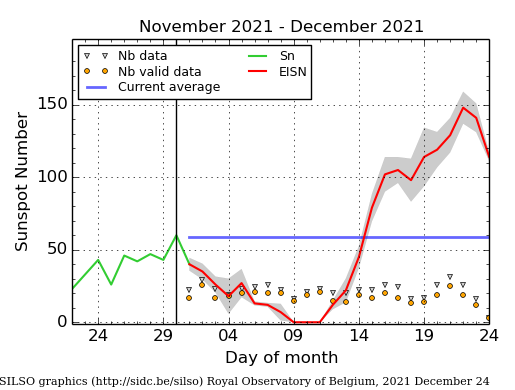
The daily Estimated International Sunspot Number (EISN, red curve with shaded error) derived by a simplified method from real-time data from the worldwide SILSO network. It extends the official Sunspot Number from the full processing of the preceding month (green line), a few days more than one solar rotation. The horizontal blue line shows the current monthly average. The yellow dots give the number of stations that provided valid data. Valid data are used to calculate the EISN. The triangle gives the number of stations providing data. When a triangle and a yellow dot coincide, it means that all the data is used to calculate the EISN of that day.
PROBA2 Observations
Solar Activity
Solar flare activity fluctuated from very low to moderate during the week.
In order to view the activity of this week in more detail, we suggest to go to the following website from which all the daily (normal and difference) movies can be accessed: https://proba2.oma.be/ssa
This page also lists the recorded flaring events.
A weekly overview movie can be found here (SWAP week 612): https://proba2.sidc.be/swap/data/mpg/movies/weekly_movies/weekly_movie_2021_12_13.mp4
Details about some of this week's events can be found further below.
If any of the linked movies are unavailable they can be found in the P2SC movie repository here: https://proba2.oma.be/swap/data/mpg/movies/
Friday Dec 17
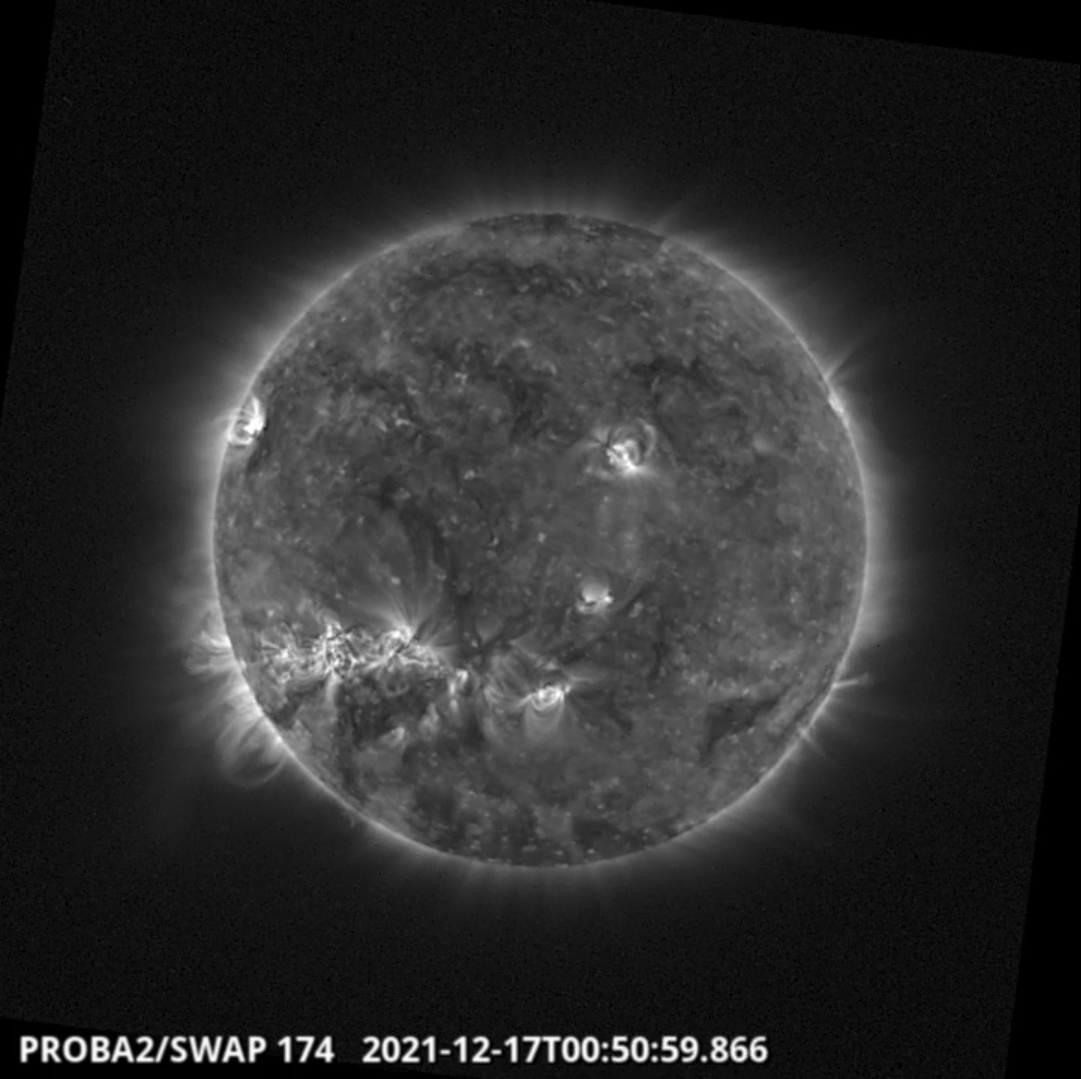
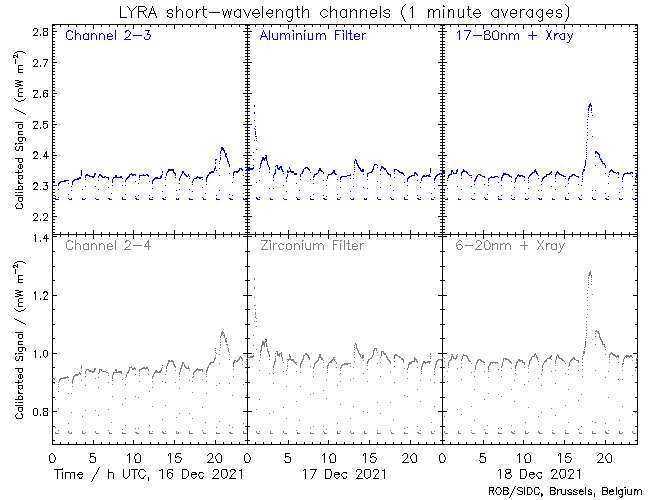
The largest flare of the week, an M1.2 flare, was observed by SWAP and LYRA. The flare was visible near the north-east limb of the solar disk on 2021-Dec-17, as shown in the SWAP image above taken at 00:50 UT.
Find a movie of the event here (SWAP movie): https://proba2.sidc.be/swap/movies/20211217_swap_movie.mp4
Noticeable Solar Events (13 Dec 2021 - 19 Dec 2021)
| DAY | BEGIN | MAX | END | LOC | XRAY | OP | 10CM | TYPE | Cat | NOAA |
| 17 | 0039 | 0051 | 0056 | N20E70 | M1.2 | 1F | 88 | 2911 |
| LOC: approximate heliographic location | TYPE: radio burst type |
| XRAY: X-ray flare class | Cat: Catania sunspot group number |
| OP: optical flare class | NOAA: NOAA active region number |
| 10CM: peak 10 cm radio flux |
Geomagnetic Observations in Belgium
Local K-type magnetic activity index for Belgium based on data from Dourbes (DOU) and Manhay (MAB). Comparing the data from both measurement stations allows to reliably remove outliers from the magnetic data. At the same time the operational service availability is improved: whenever data from one observatory is not available, the single-station index obtained from the other can be used as a fallback system.
Both the two-station index and the single station indices are available here: http://ionosphere.meteo.be/geomagnetism/K_BEL/
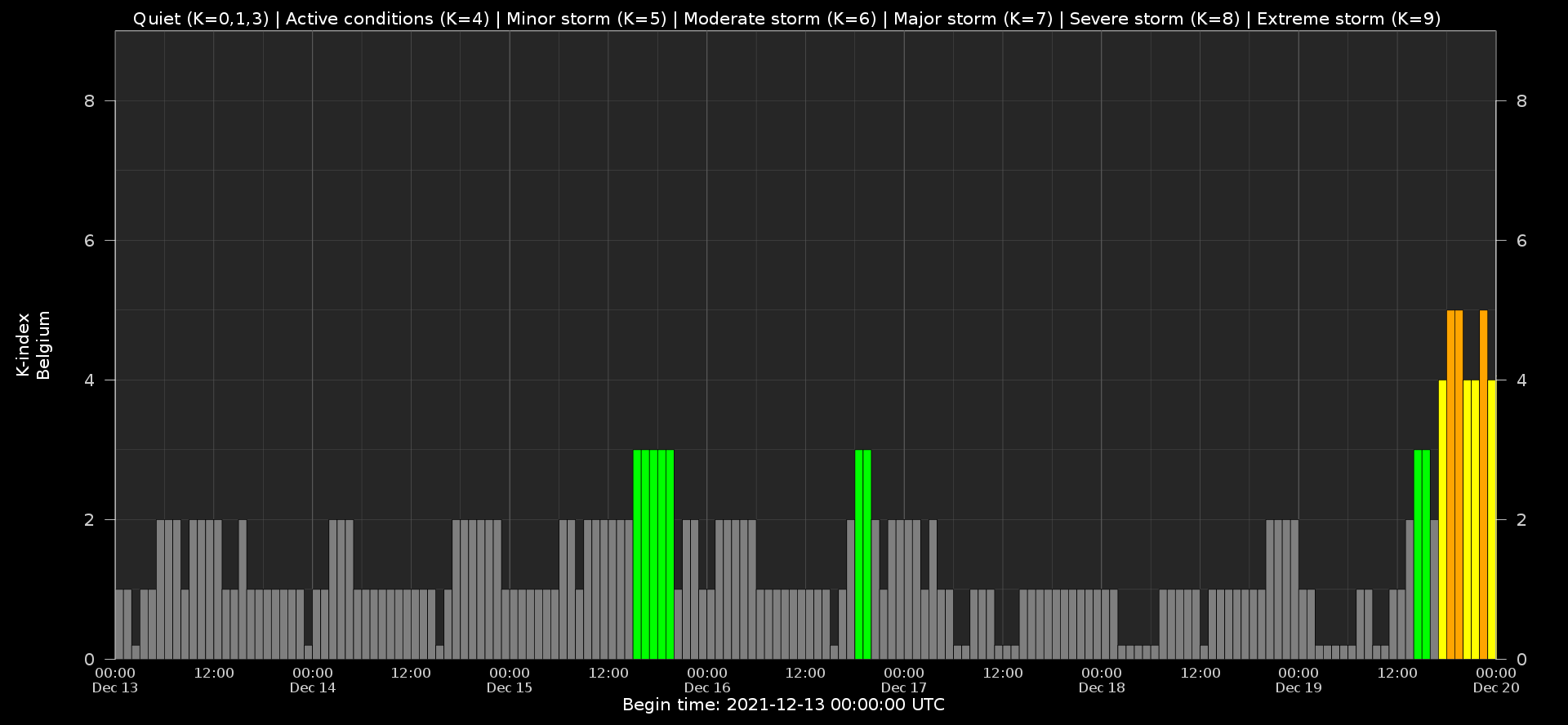
The SIDC Space Weather Briefing
The Space Weather Briefing presented by the forecaster on duty from Dec 12 to 19. It reflects in images and graphs what is written in the Solar and Geomagnetic Activity report.
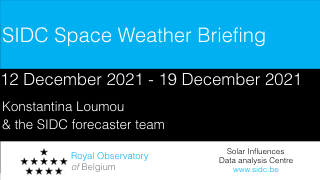
A pdf-version: https://www.stce.be/briefings/20211220_SWbriefing.pdf
The movie: https://www.stce.be/briefings/20211220_SWbriefing.m4v
Review of ionospheric activity
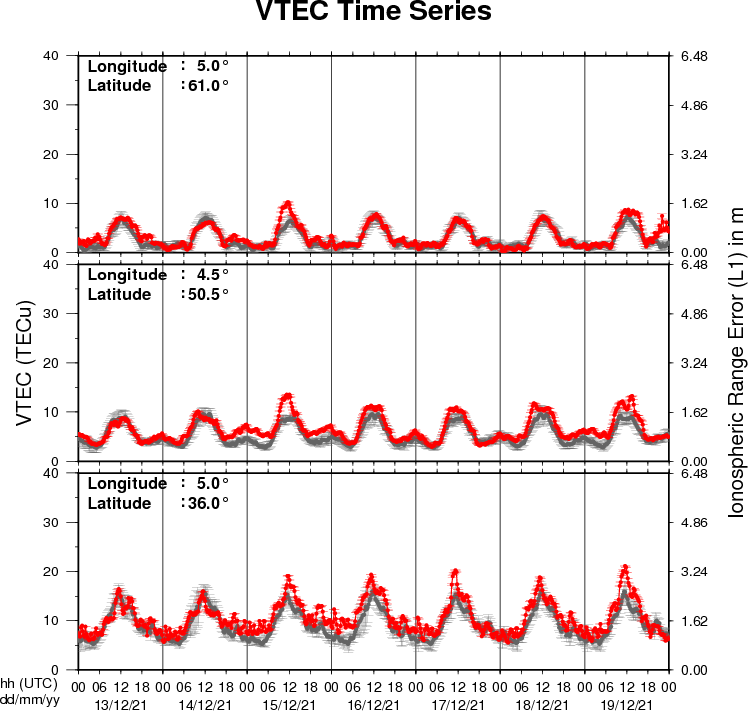
The figure shows the time evolution of the Vertical Total Electron Content (VTEC) (in red) during the last week at three locations:
a) in the northern part of Europe(N61�, 5�E)
b) above Brussels(N50.5�, 4.5�E)
c) in the southern part of Europe(N36�, 5�E)
This figure also shows (in grey) the normal ionospheric behaviour expected based on the median VTEC from the 15 previous days.
The VTEC is expressed in TECu (with TECu=10^16 electrons per square meter) and is directly related to the signal propagation delay due to the ionosphere (in figure: delay on GPS L1 frequency).
The Sun's radiation ionizes the Earth's upper atmosphere, the ionosphere, located from about 60km to 1000km above the Earth's surface.The ionization process in the ionosphere produces ions and free electrons. These electrons perturb the propagation of the GNSS (Global Navigation Satellite System) signals by inducing a so-called ionospheric delay.
See http://stce.be/newsletter/GNSS_final.pdf for some more explanations ; for detailed information, see http://gnss.be/ionosphere_tutorial.php
Action!
Check out our activity calendar: activities and encounters with the Sun-Space-Earth system and Space Weather as the main theme. We provide occasions to get submerged in our world through educational, informative and instructive activities.
If you want your event in our calendar, contact us: stce_coordination at stce.be
In 2022
* January 25, Public Lecture on the Solar Corona in EUV (Dutch), Urania, Hove, Belgium
* February 14-18, online Space Weather Introductory Course by SWEC, Space Weather Education Center - registrations are open
* February 22, Public Lecture on Space Weather and Aviation (Dutch), Urania, Hove, Belgium
* February 26, Public Lecture on Space Weather, Satellites and Aviation (Dutch), UGent Volkssterrenwacht Armand Pien, Gent, Belgium
* March 14-16, onsite (!) Space Weather Introductory Course by SWEC, Space Weather Education Center - registrations are open
* April 28, Public Lecture on SDO/EUI, Astropolis, Oostende, Belgium
* August 25, Public Lecture on Space Weather and Aviation, Astropolis, Oostende, Belgium
* October 24-28, 18th European Space Weather Week, Zagreb, Croatia
Check: https://www.stce.be/calendar
